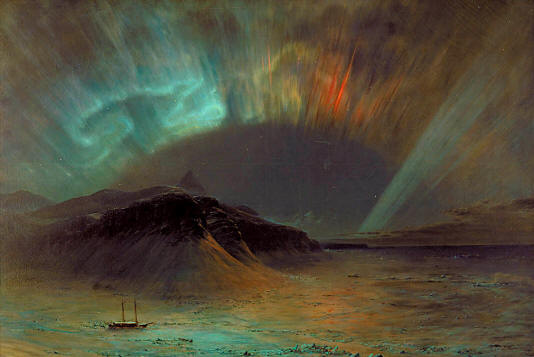|
|
|

Aurora Borealis by Frederic Edwin Church
(1865).
Smithsonian American Art Museum, Washington,
United States of America.
Go Figure!
Jun
16, 2010
To eyewitnesses, including those
at lower latitudes, highly energetic
formations produced by extremely
vigorous aurorae have often
suggested some form of painting or
supernatural inscription on the
canvas of the sky.
This was the case with observers of
the prominent aurorae spawned by the
coronal mass ejection of 1859. From
Stockton, central California, came
the report that the “great streams
of red and blue” appearing after
9:00 PM on 28th. August “would faint
and brighten in such a wonderful
manner, that we imagined some
painter in the skies drew his great
brush from the horizon up to 40 or
50 degrees, dipped with vermillion,
then with sky blue, and then with
white and flesh color.” Even more
graphically, and as far south as 13º
18´ North, an observer from La
Unión, San Salvador, reflected as
follows on the display that followed
a few days afterwards:
“On the night of Sept. 2d, a most
extraordinary phenomenon was
witnessed. … a dense black cloud
arose in the east, and commenced to
spread over the colored portion of
the heavens, presenting a most
curious spectacle; for in the parts
where the cloud was not dense
enough, the red light shone through,
and formed a thousand fantastic
figures, as if painted with fire on
a black ground.”
And certainly it must have been a
similar sentiment that drove the
talented Danish photographer and
auroral expert, Sophus Tromholt
(1851-1896), to wonder:
“Will man ever decipher the
characters which the Aurora Borealis
draws in fire on the dark sky? Will
his eye ever penetrate the mysteries
of Creation which are hidden behind
this dazzling drapery of colour and
light?”
Tromholt’s writings exude a
striking sense of intellectual
honesty regarding the boundaries of
current understanding. By
‘decipherment’ of auroral
“characters” in the sky Tromholt
clearly meant a figuring out of the
physics underlying the shapes and
colours that presented themselves to
the eye. With the passing of more
than a century, this task has been
largely accomplished by today’s
plasma physicists. At the same time,
Tromholt’s words convey the sense of
numinous awe many have felt upon
exposure to this celestial drama.
Considering the marked emotional
impact powerful aurorae tend to have
on human minds, it would not be
surprising if the appearance of
discreet light structures in the sky
had provoked similar associations
with painting in people of
prehistoric times. Seemingly charged
with religious significance, these
‘cosmic fingerprints’, in which many
strove to read omens for the future,
could have prompted human spectators
to record their observations for
posterity.
What would have been more natural
for them than to mimic the art of
the ‘gods’ to the best of their
ability – painting or carving the
selfsame images on a darker
background, perhaps leaving colours
that were reminiscent of the auroral
prototypes themselves? Arguably the
most obvious type of enduring canvas
ancient artists could resort to
would be
parietal
– the surfaces of walls and rocks,
which are found today to be filled
with millions upon millions of
paintings and carvings.
Indeed, in 1976, the American
physicist, George Siscoe, figured
that the earliest depictions of
aurorae might be found in the
‘macaronis’ or serpentine meanders
painted on rocks and cave walls:
“The most dramatic example of this
possibility is to be found on the
ceiling of the cave of Rouffignac in
France, where lines drawn in the red
clay ceiling resemble the folded
curtain patterns of the aurora.”
Although it may seem puzzling that
Cro-Magnon people would have
preoccupied themselves with a
natural phenomenon that rarely
occurs at their latitude, conditions
are bound to have been different in
the past:
“We know that there have been
more than 30 reversals of the
earth’s magnetic field in the last
10 million years. Associated
wandering of the magnetic poles
would have resulted in periods when
the aurora was seen much more
frequently at mid-latitudes than is
the case today. Consequently, it is
not unreasonable to suppose that
Stone Age man gazed with concern at
flickering auroral lights and
perhaps recorded them in his art.”
This view is endorsed by members
of NASA’s THEMIS team, who concluded
from this type of rock art that
aurorae “have influenced the course
of history, religion, and art” from
prehistoric times. Other specialists
on the polar lights have also
speculated “that a great deal of the
very ancient engravings which have
been found in several grottos along
the Mediterranean Sea are in fact
pictorial representations of the
northern light.”
Moving beyond speculation, a
recent comparison with the observed
behaviour of high-energy-density
plasmas in laboratory, in space and
according to particle-in-cell (PIC)
simulations suggests that not only
some of the French and Spanish cave
paintings of the Cro-Magnon era may
include auroral motifs, but also the
worldwide impressions on rock,
typically exposed to the open air,
that proliferated from the end of
the Palaeolithic and throughout the
Neolithic period, roughly from
11,000 BCE to 3,000 BCE, though in
many places continuing into later
periods. Rupestral art as a whole
appears as one monolithic witness to
the possibility that awe-inspiring
plasma filaments painted their
characteristic nonfigurative images
in the firmament first.
Contributed by Rens Van Der
Sluijs
http://mythopedia.info
Books by Rens Van Der Sluijs:
The Mythology of the World Axis
The World Axis as an Atmospheric
Phenomenon
|
|
|
|
|
|
|
|
|
YouTube video, first glimpses of Episode Two in the "Symbols of an Alien Sky"
series.
|
|
|
|
|
|
|
Three ebooks in the Universe Electric series are
now available. Consistently
praised for easily understandable text and exquisite graphics.
|
|
|
|
|
|
|
|
|
|







